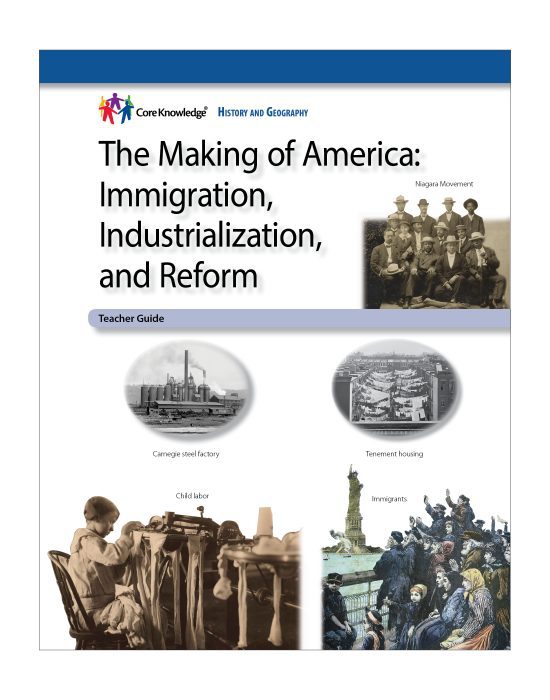The Making of America: Immigration, Industrialization, and Reform: CKHG Student Reader
$11.95
In stock
Paperback
6.7 in. W x 9.6 in. H
245 pages
ISBN: 978-1-68380-346-1
SKU: CKHGMOASR
The Making of America: Immigration, Industrialization, and Reform is a single volume divided into three separate sections (corresponding to Unit 7 , Unit 8 and Unit 9 for schools using the CKHG series in Sequence grade-level order).
- Immigration explores the history of immigration to America in the 1800s and early 1900s and the reasons why so many people left their home countries to better their lives in “the land of opportunity.” Before the Civil War, many immigrants came from northern and western Europe, and prior to this, thousands of Africans were brought to America against their will and enslaved. After the Civil War, immigrants also came from southern and eastern Europe, Asia, Mexico, and Canada. In addition, students learn that the immigrant experience often included an arduous journey, fear of deportation, settling in rural or urban areas (often in close proximity to fellow immigrants), and prejudice. But these immigrants did a great deal of the hard work that led to the growth of the United States. They contributed (and still contribute) aspects of their cultures to a vibrant American culture, and embraced the American ideals of liberty and self-government.
- Industrialization and Urbanization in America looks at the significant demographic and economic shifts that took place in the United States in the late 1800s and early 1900s, as the rise of big business ushered in an era of industrialization and urbanization across the country. During this period, the country became an industrial giant, with vast numbers of Americans moving to the cities for factory jobs, capitalist entrepreneurs becoming exceedingly rich tycoons of big business, and inventors changing the way ordinary people lived for the better. Students also learn, however, that the benefits of industrialization and invention were not shared by all. Unskilled workers in particular struggled to find work, and when they did, often worked long hours in difficult and sometimes dangerous conditions. Eventually workers formed unions to fight for better pay and working conditions, and Americans tried to rein in the power of big business and stop corruption in cities, but these efforts initially only met with limited success.
- Reform in Industrial America examines the groups and individuals who worked for political, economic, and social reform in America in the late 1800s and early 1900s. This period was a time of extremes and inequities in America, with railroad tycoons and oil magnates living in cities populated by impoverished immigrant factory workers, many farmers struggling to survive, African Americans living under Jim Crow laws that took away their civil rights, and women still not allowed to vote. Students also learn that populist farmers, muckrakers, urban reformers, suffragettes, civil rights leaders, and social reformers worked to ease the credit crunch, expose the excesses of big business, improve tenement housing, obtain equal rights for African Americans and for women, and improve the lives of workers. President Theodore Roosevelt pushed for conservation measures, and Americans showed they could work together to improve the lives of ordinary citizens.
CKHG Grade 6 - Sets

Homeschool Set
The Making of America: Immigration, Industrialization, and Reform: CKHG Homeschool Set
$71.85

Classroom Set
The Making of America: Immigration, Industrialization, and Reform: CKHG Classroom Set
$358.65

Student Book / Reader
CKHG Grade 6 Student Reader Set
$63.70

Grade-Level Set
CKHG Grade 6 Complete Grade-Level Set
$1,864.95
Please review our Return and Discrepancy Policy.
Frequent customer? Consider creating an account to speed up your checkout process. Please call us at (800) 238-3233 or use our customer support form for help to complete your order.



